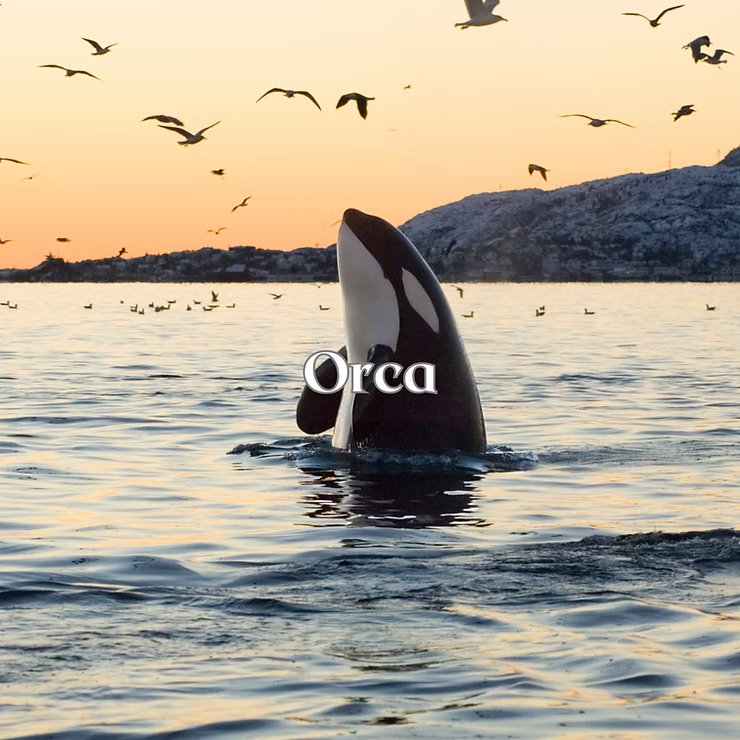Introduction
Orcas, also known as killer whales, are majestic predators and the largest members of the dolphin family. Recognized by their striking black and white coloration and incredible swimming abilities, they dominate oceans across the globe. These apex predators not only showcase remarkable intelligence and hunting skills but also thrive in diverse marine environments, forming strong social bonds and playing vital roles in ecosystems. Beyond biology, orcas hold cultural significance, symbolizing strength and wisdom, while facing challenges from human activities that threaten their survival.
Physical Characteristics
Distinctive Appearance
Orcas are instantly recognizable by their bold black-and-white coloration. Each individual has unique markings, similar to human fingerprints, making them easy to identify. Their coloration also helps camouflage them, blending with the ocean surface and depths depending on perspective.
Size and Power
Adult orcas can reach lengths of up to 30 feet and weigh as much as 10 tons. Their muscular tails propel them through the water at speeds of up to 34 miles per hour, making them agile hunters capable of long-distance travel.
Agile Swimmers
Known for breaching, tail-slapping, and acrobatic spins, orcas display athleticism that aids in communication, hunting, and play. These behaviors are not only spectacular to watch but also critical for survival.
Habitat and Distribution
Cold and Temperate Waters
Orcas are highly adaptable and inhabit oceans worldwide, from the Arctic to the Antarctic. They thrive in cold and temperate waters, often following prey availability and seasonal migrations.
Migration Patterns
Orcas travel vast distances in search of food. Many populations migrate seasonally, following salmon runs or shifting marine mammal populations. These migrations highlight their adaptability and endurance.
Diet and Hunting Strategies
Apex Predators
As top predators, orcas feed on fish, squid, seals, sea lions, and even whales. Their diverse diet demonstrates their adaptability across ecosystems.
Cooperative Techniques
- Wave-washing: Creating waves to knock seals off ice floes.
- Carousel feeding: Circling schools of fish to trap them before striking.
- Beach hunting: Temporarily stranding themselves to catch seals onshore.
These strategies show remarkable intelligence and teamwork within pods.
Social Structure and Communication
Pod Life
Orcas live in pods led by matriarchs. These family groups can include multiple generations, emphasizing loyalty and cooperation. Pods share hunting responsibilities and protect calves together.
Communication and Echolocation
Each pod has a unique set of vocalizations passed down through generations. Orcas use whistles, clicks, and echolocation not only to navigate but also to coordinate hunting and reinforce social bonds.
Reproduction and Life Cycle
Mating and Calving
Breeding usually occurs in spring, and females undergo a long gestation period of 15 to 18 months. Calves, born tail-first, are cared for not just by mothers but also by other pod members, ensuring survival through cooperative care.
Lifespan
In the wild, orcas can live up to 70 years, with females often outliving males. Their longevity reflects their adaptability and strong family support systems.
Threats and Conservation
Human Impact
Pollution, overfishing, and noise disturbance pose serious threats to orcas. Chemical toxins accumulate in their bodies, while noise pollution disrupts their communication and echolocation.
Conservation Efforts
- Reducing pollutants in marine ecosystems.
- Implementing sustainable fishing practices.
- Monitoring and protecting key orca habitats.
Public education and scientific research are essential in ensuring orcas’ survival for future generations.
Cultural Significance
Indigenous Symbolism
For many Indigenous cultures, orcas represent strength, protection, and wisdom. They appear in myths as guardians of the sea and guides for humanity.
Orcas in Popular Culture
From films like Free Willy to global conservation campaigns, orcas inspire awe and symbolize the struggle to preserve marine life. They remain cultural icons of power and freedom.
Conclusion
Orcas embody strength, intelligence, and deep social bonds, making them one of the ocean’s most remarkable creatures. Yet they face increasing challenges from human impact. By supporting conservation efforts and respecting their habitats, we can ensure orcas continue to thrive and inspire future generations with their majesty and resilience.

